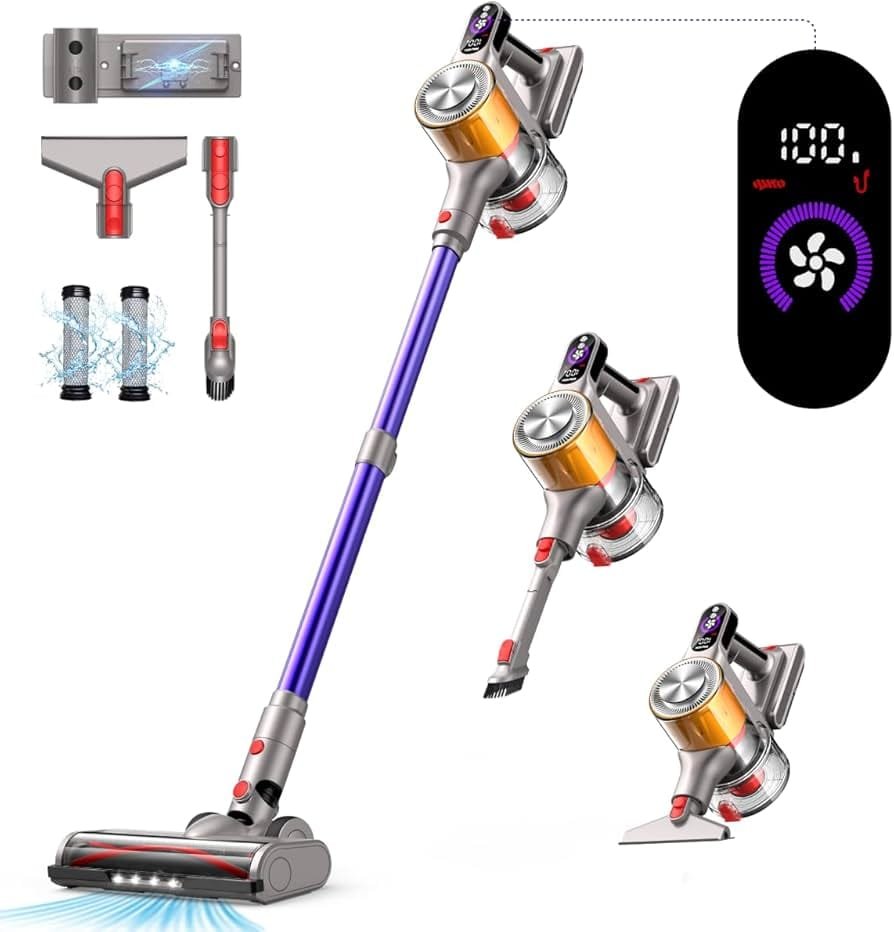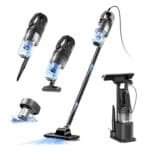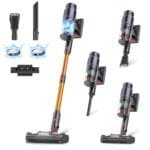Quiet vacuum motors reduce noise through innovative technology. They make cleaning less disruptive.
Understanding how these motors work can be fascinating. Noise reduction in vacuum motors involves several key techniques. These include soundproofing materials, improved motor design, and advanced airflow systems. Each method plays a part in minimizing the noise produced during operation.
This blog will explain these techniques in detail. You’ll learn about the science behind quieter motors. Plus, we’ll discuss the benefits of using a quieter vacuum. By the end, you’ll appreciate the effort put into making your vacuum less noisy. So, let’s dive into the world of quiet vacuum motors and discover how they keep the peace in your home.
Introduction To Quiet Vacuum Motors
Have you ever noticed how loud some vacuum cleaners are? It’s almost like a jet engine in your living room. Quiet vacuum motors aim to solve this problem. They are designed to keep noise levels low without sacrificing performance. Let’s dive into what makes these motors so special.
Importance Of Noise Reduction
Why does noise reduction matter in vacuum cleaners? Imagine trying to clean your home while your baby is sleeping or during a conference call. A quieter vacuum can make a big difference in your daily life.
Noise reduction also improves your overall cleaning experience. You can clean without disturbing others, making it a win-win for everyone. Plus, quieter vacuums are often seen as higher quality, adding value to your investment.
Overview Of Motor Technology
Understanding the technology behind quiet vacuum motors can be fascinating. These motors use innovative design to reduce noise. For instance, they often feature better insulation and advanced materials that absorb sound.
One key component is the motor’s fan design. Traditional fans can be noisy, but newer models have blades designed to minimize turbulence. This small change can significantly reduce noise levels.
Another factor is the motor’s speed control. By adjusting the speed, the motor can run more quietly without losing suction power. This balance is crucial for effective, quiet cleaning.
Have you ever used a quiet vacuum motor? How did it change your cleaning routine? Share your thoughts in the comments below!
Understanding the importance and technology behind quiet vacuum motors can help you make a more informed choice. Next time you’re in the market for a vacuum, consider how much noise it will make. Your ears will thank you!
Components Of Quiet Vacuum Motors
Understanding the components of quiet vacuum motors can help you appreciate the technology that keeps your home clean without the noise. These motors are designed with specific parts that work together to reduce sound while maintaining efficiency. Let’s break down the key components that make these motors so effective.
Motor Design
The design of the motor plays a crucial role in noise reduction. Engineers focus on creating a balanced motor that minimizes vibrations. Reduced vibrations mean less noise. A well-balanced motor also lasts longer, offering you better value for your money.
Think about the last time you used a noisy vacuum. The constant hum and vibration can be annoying. Quiet vacuum motors are designed with precision to avoid this. They use advanced engineering techniques to keep everything running smoothly.
Insulation Materials
Insulation materials are another essential component. These materials absorb sound, preventing it from escaping the motor housing. High-quality foam or rubber is often used for this purpose. The result is a quieter vacuum that doesn’t disturb your household.
You might have noticed some vacuums have a soft, almost cushioned feel. This is due to the insulation materials. They not only reduce noise but also contribute to the overall durability of the vacuum. Better insulation means a more pleasant cleaning experience.
Have you ever wondered why some vacuum cleaners are so quiet while others are loud? The secret lies in these components. By focusing on motor design and insulation materials, manufacturers create vacuums that perform well without the noise. Next time you shop for a vacuum, consider these features to ensure a peaceful cleaning experience.
Noise Reduction Principles
Quiet vacuum motors reduce noise by using sound-dampening materials and advanced engineering. Special components minimize vibrations and airflow disturbances. These techniques ensure a quieter cleaning experience.
Understanding how quiet vacuum motors work starts with noise reduction principles. These principles focus on reducing sound and vibration. This makes the vacuum cleaner quieter.Sound Dampening Techniques
Sound dampening techniques play a big role. Engineers use materials that absorb sound. Foam and rubber are common choices. These materials reduce the noise produced by the motor.Motor housing also matters. A well-designed housing contains the noise. It stops the sound from escaping into the room. This creates a quieter experience.Vibration Control
Vibration control is equally important. Vibrations create noise. Reducing vibrations lowers the overall sound level.Rubber mounts and pads help. They isolate the motor from the vacuum body. This prevents vibrations from spreading.Balanced motor parts also help. They ensure smooth operation and less vibration. This makes the vacuum quieter and more pleasant to use. “`
Credit: www.amazon.com
Advanced Motor Technologies
Quiet vacuum motors use advanced motor technologies to reduce noise. These technologies focus on improving efficiency and reducing sound levels. Let’s dive into two key innovations: brushless motors and magnetic levitation.
Brushless Motors
Brushless motors generate less noise compared to traditional motors. They lack brushes, which often cause friction and noise. Instead, they use electronic controllers to manage motor functions. This results in quieter operation. They also last longer due to fewer moving parts. Less wear and tear means less noise over time.
Magnetic Levitation
Magnetic levitation, or maglev, is another breakthrough. It uses magnets to lift and move the motor parts. This reduces contact and friction. Less friction leads to quieter operation. Maglev technology also improves motor efficiency. The motor runs smoother and quieter. These advancements make vacuuming a quieter experience.
Engineering Challenges
Creating quiet vacuum motors involves various engineering challenges. Engineers must balance performance and noise reduction. This is not an easy task. The goal is to make a powerful yet quiet vacuum motor. These challenges can affect the material and design choices.
Balancing Performance And Noise
Engineers face a big challenge. They need to create a motor that performs well but makes less noise. Strong motors often create more noise. Reducing noise usually means lowering the motor’s power. Finding a middle ground is key. Engineers use advanced techniques to manage this balance.
They design special motor parts. These parts help lower the noise without cutting performance. Engineers also use sound-absorbing materials. These materials help to reduce the noise levels. This balance is crucial for a quiet vacuum motor.
Material Limitations
Material choices also present challenges. Some materials are good for noise reduction but are not durable. Others are strong but loud. Engineers need to pick the right materials. This ensures the motor is quiet and long-lasting.
They test different materials for the best results. Some materials can absorb sound better. Others can withstand wear and tear. Finding the right mix is important. This helps in creating a quiet and efficient vacuum motor.

Credit: www.ms-quietbox.com
Testing And Measurements
Quiet vacuum motors use special designs to reduce noise. They include sound-absorbing materials and advanced airflow systems. This ensures a peaceful cleaning experience.
When it comes to understanding how quiet vacuum motors work, testing and measurements play a crucial role. These tests help determine the effectiveness of noise reduction techniques and ensure the vacuum operates quietly. By examining decibel levels and frequency analysis, we can gain insights into the noise characteristics of vacuum motors.Decibel Levels
Decibel levels measure the intensity of sound. Testing the decibel levels of vacuum motors involves using a sound level meter. This device captures the noise produced by the motor in decibels (dB).During testing, you might notice quieter vacuums often operate below 70 dB. This range is comparable to normal conversation levels. For a real-world example, think about how a library feels compared to a busy street. The lower the decibel level, the quieter the vacuum.But why does this matter? Lower decibel levels mean less disturbance at home. If you have pets or young children, a quieter vacuum can make a big difference.Frequency Analysis
Frequency analysis breaks down the noise into different pitches or frequencies. This helps identify which sounds are most prominent. Engineers use this data to address specific noise issues.High-pitched sounds can be more annoying than low-pitched ones. By analyzing the frequency, manufacturers can focus on reducing these irritating noises. Think about the difference between a high-pitched whistle and a low hum. Most people find the whistle more bothersome.Personal experience: I once tested two vacuums side by side. One had a high-pitched whine, while the other had a low, steady hum. The high-pitched vacuum was far more annoying, even though both had similar decibel levels.In testing, engineers use tools like spectrum analyzers to visualize the noise. They can then target specific frequencies for reduction. This process ensures a more pleasant user experience.In conclusion, testing and measurements like decibel levels and frequency analysis are vital. They help manufacturers create quieter vacuums that are less disruptive. Have you ever noticed how some vacuums are more irritating than others? Now you know why! By focusing on these tests, we can enjoy a quieter, more peaceful home.Applications Of Quiet Motors
Quiet vacuum motors are becoming increasingly popular due to their noise reduction capabilities. These advanced motors are designed to minimize noise, making them ideal for various applications. Let’s explore where these quiet motors are most beneficial.
Residential Use
Quiet motors in vacuums are perfect for homes. They allow for cleaning without disturbing family members or pets. Parents can vacuum while their children sleep. Early risers can clean without waking the whole house. This creates a peaceful environment.
Commercial And Industrial Use
Businesses benefit greatly from quiet vacuum motors. Offices can maintain cleanliness without disrupting work. In hotels, staff can clean rooms at any time without disturbing guests. Hospitals and clinics also prefer quiet vacuums. They help maintain a serene atmosphere for patients. Industrial settings appreciate quieter operations. It reduces noise pollution and improves worker comfort.
Future Trends
Quiet vacuum motors use advanced technology to minimize noise. Special insulation materials and optimized airflow reduce sound levels. This makes vacuuming a more pleasant experience.
### Future TrendsIn the quest for quieter homes, vacuum motor technology is constantly evolving. The future holds exciting possibilities for even quieter and more efficient vacuum cleaners. Let’s delve into the innovations poised to transform this essential household appliance.###Innovations In Motor Technology
The latest advancements in motor technology promise significant noise reductions. Brushless motors are becoming more common due to their quieter operation and longer lifespan. They generate less friction, leading to less noise.Another innovation is the use of advanced soundproofing materials within the vacuum. These materials absorb and dampen sound waves, reducing the noise output. Imagine vacuuming without having to raise your voice to talk to someone nearby.Manufacturers are also experimenting with variable speed motors. These motors adjust their speed based on the surface, using less power and producing less noise on hard floors compared to carpets.###Potential Market Impact
Quieter vacuum motors could revolutionize the market. Consumers are increasingly seeking appliances that make their lives easier and less disruptive. A quieter vacuum motor fits this trend perfectly.Consider the impact on homes with young children or pets. A vacuum that doesn’t scare pets or wake a sleeping baby would be a game-changer. This could make quiet vacuum motors highly desirable.Moreover, quieter vacuums could find a significant market in commercial spaces. Offices, hotels, and other businesses would benefit from maintaining cleanliness without creating a noise disturbance.Have you ever had to pause a conversation or a TV show because of a loud vacuum cleaner? With these future trends, that could become a thing of the past. As these technologies become more widespread, we can expect quieter, more efficient, and user-friendly vacuum cleaners to dominate the market.
Credit: www.viatomcare.com
Frequently Asked Questions
How Do You Reduce The Noise On A Vacuum Pump?
Reduce vacuum pump noise by installing a muffler or silencer. Use vibration isolation mounts. Regularly maintain and lubricate the pump.
How Do Silent Vacuums Work?
Silent vacuums work by using advanced motor technology, sound insulation, and efficient airflow systems. These features reduce noise levels significantly.
How Many Db Is A Quiet Vacuum Cleaner?
A quiet vacuum cleaner operates at around 60 to 65 decibels (dB). This noise level is comparable to normal conversation.
How To Reduce Noise From A Vacuum Cleaner?
To reduce vacuum cleaner noise, use rubber nozzles and attachments. Clean filters regularly. Choose quieter models. Use on carpets or rugs.
Conclusion
Understanding quiet vacuum motors helps reduce noise in your home. These motors use advanced designs and materials. This makes them quieter and more efficient. Everyone enjoys a peaceful environment. Less noise means more comfort. With this knowledge, you can choose the right vacuum.
A quiet home is a happy home. Enjoy the silence while cleaning.





